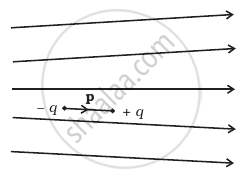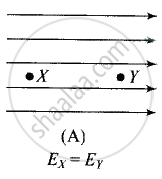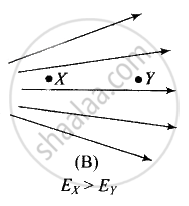Advertisements
Advertisements
Question
Figure shows electric field lines in which an electric dipole P is placed as shown. Which of the following statements is correct?

Options
The dipole will not experience any force.
The dipole will experience a force towards right.
The dipole will experience a force towards left.
The dipole will experience a force upwards.
Solution
The dipole will experience a force towards left.
Explanation:
If the lines of force are equidistant and parallel straight lines, the field is uniform and if either lines of force are not equidistant, or straight line or both, the field will be non-uniform. The number of electric field lines passing per unit area is proportional to the strength of the electric field. For example, see the following figures:


Hence in a given question, from the given pattern of electric field lines, it is clear that the strength of the electric field decreases from left to right. As a result force on charges also decreases from left to right.
Here in the given figure, the force on charge -q is greater than the force on charge +q in turn dipole will experience a force towards left.
APPEARS IN
RELATED QUESTIONS
Why do the electrostatic field lines not form closed loops?
Why do the electric field lines never cross each other?
- An electrostatic field line is a continuous curve. That is, a field line cannot have sudden breaks. Why not?
- Explain why two field lines never cross each other at any point?
A point charge (+Q) is kept in the vicinity of an uncharged conducting plate. Sketch the electric field lines between the charge and the plate?
The intensity of the electric field at a perpendicular distance of 0·5 m from an infinitely long line charge having linear charge density (λ) is 3-6 × 103 Vm-1. Find the value of λ.
Explain why two field lines never cross each other at any point?
A point positive charge is brought near an isolated conducting sphere (figure). The electric field is best given by ______.
An electron enters an electric field with its velocity in the direction of the electric lines of force. Then ______
The magnitude of the electric field due to a point charge object at a distance of 4.0 m is 9 N/C. From the same charged object the electric field of magnitude, 16 N/C will be at a distance of ______.
